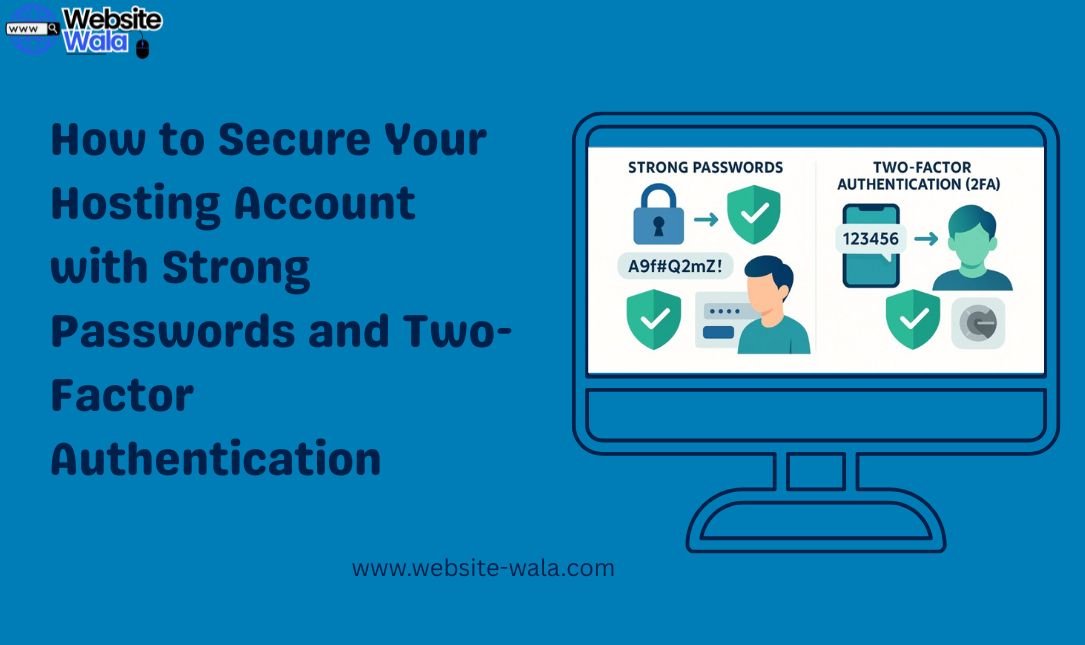
Learn How to Secure Your Hosting Account with Strong Passwords and Two-Factor Authentication to enhance website security and prevent unauthorized access.
Introduction
In today’s digital era, securing your online assets is more critical than ever. For website owners, the hosting account is the gateway to your entire digital presence. Understanding How to Secure Your Hosting Account with Strong Passwords and Two-Factor Authentication is essential to safeguard sensitive data and ensure uninterrupted website operations. Weak passwords and lack of additional authentication layers are among the leading causes of cyberattacks, data breaches, and unauthorized access. Implementing hosting security best practices can significantly reduce these risks.
Why You Need to Secure Your Hosting Account
Your hosting account contains vital information, including website files, databases, and email accounts. If compromised, it can lead to severe consequences such as:
-
Loss of sensitive customer data
-
Website downtime affecting business credibility
-
Malware infection spreading to users
-
Financial and reputational damage
By following How to Secure Your Hosting Account with Strong Passwords and Two-Factor Authentication, you can prevent unauthorized access and protect your online assets from malicious attacks. Website security starts with a strong foundation, and your hosting account is that foundation.
Step 1: Use Strong Passwords
The first step in securing your hosting account is using strong passwords. Weak or reused passwords make it easy for attackers to gain access. Here’s how to create a strong password:
-
Use a minimum of 12 characters, combining uppercase, lowercase, numbers, and symbols.
-
Avoid using common words, sequential numbers, or personal information.
-
Use a password manager to generate and store unique passwords for each account.
-
Regularly update your passwords to prevent long-term vulnerabilities.
Implementing strong passwords is a simple yet powerful way to strengthen your account’s defense. It is a fundamental component of hosting security best practices.
Step 2: Enable Two-Factor Authentication (2FA)
Even the strongest password can be compromised, which is why two-factor authentication is critical. 2FA adds an extra layer of protection by requiring a second verification method in addition to your password.
Common forms of 2FA include:
-
SMS-based verification codes
-
Authenticator apps like Google Authenticator or Authy
-
Hardware security keys
By activating two-factor authentication, even if a password is stolen, unauthorized users cannot access your hosting account. This step is indispensable for unauthorized access prevention and is a cornerstone of website security.
Step 3: Limit Login Attempts and Use IP Restrictions
Another way to strengthen your hosting account security is by limiting login attempts. Most hosting platforms allow you to restrict the number of failed login attempts, which helps prevent brute-force attacks. Additionally, IP restrictions can further enhance security by allowing only trusted IP addresses to access the account.
These measures complement How to Secure Your Hosting Account with Strong Passwords and Two-Factor Authentication by adding multiple barriers against attackers. Implementing multiple security layers significantly improves data protection.
Step 4: Regularly Monitor Account Activity
Monitoring account activity is a proactive approach to hosting security best practices. Most hosting providers offer activity logs that track:
-
Successful and failed login attempts
-
File changes and updates
-
Configuration changes
By keeping an eye on your account’s activity, you can quickly detect suspicious behavior and act to prevent breaches. Combining this monitoring with strong passwords and two-factor authentication ensures a comprehensive security setup.
Step 5: Keep Your Software and Plugins Updated
Outdated software and plugins are common entry points for hackers. Regular updates are crucial for maintaining website security. Make sure your CMS, plugins, and server software are always running the latest versions.
Following How to Secure Your Hosting Account with Strong Passwords and Two-Factor Authentication involves not just protecting login credentials but also addressing all potential vulnerabilities that could compromise your account and data.
Step 6: Backup Your Data Regularly
Even with top-notch security, incidents can occur. Regular backups are an essential part of data protection. Schedule automatic backups of your website files and databases to quickly restore your website in case of a security breach.
Backups also reduce the impact of accidental file deletion, ransomware attacks, and server failures, ensuring business continuity while supporting unauthorized access prevention strategies.
Step 7: Educate Yourself and Your Team
A secure hosting environment relies not just on technology but also on awareness. Training your team on hosting security best practices such as recognizing phishing attempts, using strong passwords, and enabling two-factor authentication ensures that human errors don’t compromise your account.
By emphasizing security culture, you enhance your efforts in How to Secure Your Hosting Account with Strong Passwords and Two-Factor Authentication and strengthen overall website security.
Conclusion
Securing your hosting account is not optional—it’s essential. By understanding How to Secure Your Hosting Account with Strong Passwords and Two-Factor Authentication, you protect your website, safeguard sensitive data, and prevent unauthorized access. Implementing strong passwords, enabling two-factor authentication, monitoring account activity, updating software, limiting login attempts, and maintaining regular backups collectively form hosting security best practices.
By taking these steps seriously, you ensure long-term data protection and a safer online presence for your website. Start today and make website security a top priority—it’s the most reliable way to secure your hosting account against evolving cyber threats.























